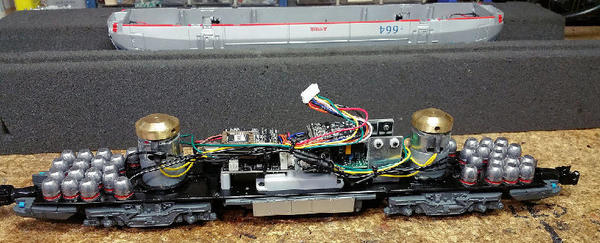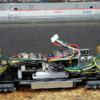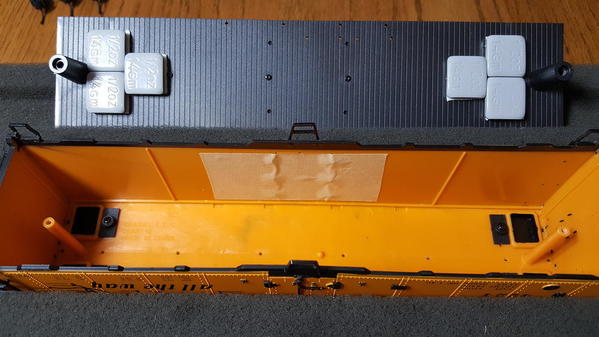Do you add extra weight to your rolling stock? I usually add extra weight to MTH 50' hi cube boxcars and auto racks.
Replies sorted oldest to newest
I used double sided tape to add half a door hinge on each end (so you could not see them if the door came open) in a box car, which for some unknown reason wanted to derail. the hinge weight fixed it. I like the idea of the auto rack- the MTH I have is very top heavy, but where in the world do you put it?
I would be really interested how people weight their cars! It was suggested to me one time that the small magnetic weights they use for tires would work for this purpose. Never tried it! Really interested in this topic and the responses!
I have added weight to a lot of cars, and a few engines as well.
For the BEEP I added them underneath, and also a stack where ever I could inside. Those are 1oz wheel weights. Inside there's about four or five more ounces. Since I needed to remove the traction tire so I'd have at least two wheels on an outside rail with signal rails, I needed more weight for some traction.
For my HHP-8, I added a pound of weight, .45ACP style. ![]() It made a huge difference in it's pulling power! It went from pulling three or four 18" passenger cars max to pulling nine of them.
It made a huge difference in it's pulling power! It went from pulling three or four 18" passenger cars max to pulling nine of them.
Attachments
John, with the cost of 45 ammo these days that is an awfully expensive way to weigh your trains down! ![]()
play trains posted:I would be really interested how people weight their cars! It was suggested to me one time that the small magnetic weights they use for tires would work for this purpose. Never tried it! Really interested in this topic and the responses!
I had an Atlas hopper whose interior weights had come loose, glue had dried up or whatever. I didn't want to deal with the hassle and mess of hot-gluing them back in place, so I tried inserting some of the adhesive-backed weights. Seemed to work fine.
I used to make golf clubs and had a roll of lead tape left over, which is used in fitting clubs. A few strips of lead tape stuck to the floor of my boxcar did the trick.
EricBuzz posted:John, with the cost of 45 ammo these days that is an awfully expensive way to weigh your trains down!
Crappy bullets, I didn't like their performance, so I have about 15 pounds of them to use in other ways. ![]() It's not loaded ammo, the bullets are only a few cents each.
It's not loaded ammo, the bullets are only a few cents each.
PAUL ROMANO posted:Do you add extra weight to your rolling stock?
Generally, yes. I use either salvaged printer's lead type, or lead plumes flashing.
mike.caruso posted:play trains posted:I would be really interested how people weight their cars! It was suggested to me one time that the small magnetic weights they use for tires would work for this purpose. Never tried it! Really interested in this topic and the responses!
I had an Atlas hopper whose interior weights had come loose, glue had dried up or whatever. I didn't want to deal with the hassle and mess of hot-gluing them back in place, so I tried inserting some of the adhesive-backed weights. Seemed to work fine.
Mike, I often use double stick tape to secure my weights.
Concerning how weights are held in place; nothing better than Walthers Goo!
Yes. I use stick-on wheel-balancing weights. I buy them at Harbor Freight, and they are available in 1/4-oz. and 1/2-oz. sizes. Pictured below are the 1/2-oz. size being installed on the floors of Weaver 40' boxcars. The adhesive backing that comes on them is more than sufficient to securely hold them in place, but I like to over-engineer everything, so I also add hot glue as well. I like to install them before I paint/weather the floors.
Attachments
I weigh allmy rolling stock to nmra O scale recommend of 5oz plus 1oz per carlrngth inch. The only exception are the mth autoracks weight at 30 oz- that is over the nmta weight but prevents tipping. O use 7mm shot purchased in a 25lb bag last Century as was recommend on this forum. I still have a lot of shot to go!
Weaver cars almost had to be weighted. Being so light with plastic trucks and couplers to keep them on the track they needed weight. Then the plastic couplers would break.
Ive used weights from some of my old HO engines I have lying around. This works real well, and a very cost effective way. ��
Here is a track cleaning car based on a forum post I made. Using the weights from an HO engine.
Attachments
I used to weight cars and engines with Cerrobend low temp alloy. A friend had a govt job and gave me 25 lbs. You can melt it and pour right into a plastic body. But then Lionel came out with the scale stuff about 15 years ago. The key is that these freight cars have only 3 grams of rolling resistance which is half to a quarter of the other brands. So in essence you can pull at least twice as many cars around curves without having to add extra weight. I've pulled 60 cars around 81" curves and with just one engine.
I bought a digital postal scale on eBay for $15 shipped and 1/2 ounce stick-on weights from Harbor Freight. I bring all my cars up to NMRA recommendations and they track much better. You may not pull as many up a grade, but that's when you add another powered unit to the consist. ![]()
John:
I like the use of bullets for weight if you're not going to use them. I don't reload so I just buy in bulk from LAX Ammo ($160 for 500 rounds of .45ACP FMJ reloads). It's great range ammo. I like shooting a .45 but at 35-40 cents a round I get post-range sticker shock. ![]()
Manty Rail Fan posted:
Hey I have this car got it used.I add weight to some of my cars.I use pennies or small peaces wood to weight them down.
PAUL ROMANO posted:Weaver cars almost had to be weighted. ...
agreed... i used to be a big fan of their PS1 boxcars but kept having derailing problems until i glued two fender washers over each truck. after that, never a problem again.
cheers...gary
I certainly do, especially on older weaver cars. The O scale weight standard is 5oz + 1oz per inch of car.
Only to the earlier year weaver boxcars. I would hot glue 2oz pyramid fishing weights, one over each truck. BTW never had anissue with the plastic trucks/couplers
Yep, added the double sided weights pictured above.
For those who add weight to their cars, does it help quiet them at all? I have some light weight passenger cars that sound like slot cars as they go around the track. I am hoping weight might help this.
BPars posted:For those who add weight to their cars, does it help quiet them at all? I have some light weight passenger cars that sound like slot cars as they go around the track. I am hoping weight might help this.
It does quiet them down. It quiets some cars more than other depending on configuration and original weight. Place the weight as low and as close to the trucks as possible. 1/4 ounce and 1/2 ounce stick-on weights are the best to use. You can get them on eBay -- most are non-lead now but you can still get lead weights which are a bit smaller.
The Lionel ice reefers are under weight so I add 3 oz to each one. They roll freely out of the box, but the extra weight really improves their free rolling ability.
The doors get taped shut with masking tape from the inside so they don't keep popping open all the time. Easily removed if you want to weather and model the inside of the car, yet can't see the weights. If you are going to model the inside of the car, just spay them black or whatever color you're using on the floor to disguise the weights.
Attachments
Fishing weights added when needed.....epoxy them in place.
We offer a line of freight car weights that will fit properly and give the proper amount of weight check out our website page:
http://www.scalecitydesigns.com/WEIGHTS_c_64.html
There are nine different weights for weaver, intermountain as well as red caboose.
I use old lead bullets that I didn't like the performance of for their intended purpose. I have probably 25-30 pounds of .45ACP that I'll never load, they make excellent rolling stock weights. ![]()
I use number 11ga(.120in thick) by 1 inch wide by 6 ft long rot rolled steel strip that is available at Menards where they sell welding supplies. The NMRA recommends for O Scale the initial weight of the car to be 5.5 oz plus additional weight per inch of car length of 1 oz. For a 40 foot (10 inch) weaver boxcar the recommended weight for this car is 15.5 oz, I purchased a inexpensive plastic dietary scale that measures weight in ounces for under $10.00 at the local ACE Hardware two or three years ago, The car with the trucks are weighed on this scale and subtracted from 15.5 oz, this is the recommended weight in ounces to be added. For Weaver 40ft. boxcars I get 8 cut lengths of 8.75 inches long plus a drop of 2 inches from the 6 ft, steel strip. The 8.75 inch steel strip is fastened to the box car floor with RTV, weight should be symmetrically positioned relative to the inside length and width of the car. The cost of this steel strip is approximately $6.00 and a tube of RTV Is around $4.00 to $5.00 if my memory is correct. The tube of caulk covers the application of more car weight that the 8 cut lengths fro the stock steel strip length.
Also note, the light car weight(Car and Trucks) varies by car type and manufacturer, weight the car first to determine the light weight to determine the recommended car weight. Some cars such as coal car a limited amount of weight can only be applied to the underframe of the car, weights may be required to be applied to the inside of the hoppers or use a coal, sand, iron ore or gravel top load to the car.
I have added weight to cheap light locomotives to improve traction. I also add weight to light coal tenders that do not have a whistle unit as light coal tenders tend to derail more often when pulling heavy train consists around my 027 curves.
Many modern rail cars with cheap plastic trucks and or plastic wheels often need some more weight.
I use lead from tire weights or other junk lead.
Charlie












